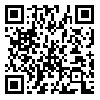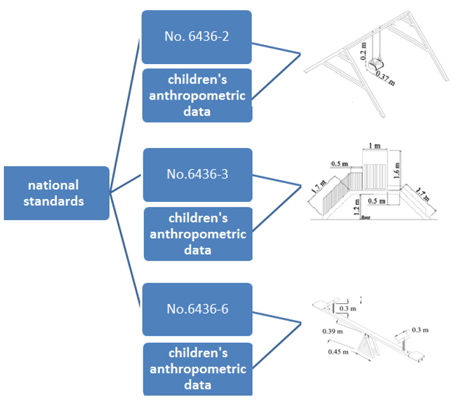Volume 11, Issue 3 (9-2021)
J Health Saf Work 2021, 11(3): 458-475 |
Back to browse issues page
Download citation:
BibTeX | RIS | EndNote | Medlars | ProCite | Reference Manager | RefWorks
Send citation to:



BibTeX | RIS | EndNote | Medlars | ProCite | Reference Manager | RefWorks
Send citation to:
Beheshti M H, Hajizadeh R, Alami A, Emkani M, Mansouri Y, Tajpoor A. Design of children’s play equipment (slides, swing, See-Saw) in urban Parks based on national standards and children’s anthropometric data. J Health Saf Work 2021; 11 (3) :458-475
URL: http://jhsw.tums.ac.ir/article-1-6539-en.html
URL: http://jhsw.tums.ac.ir/article-1-6539-en.html
Mohammad Hosein Beheshti1 
 , Roohalah Hajizadeh2
, Roohalah Hajizadeh2 
 , Ali Alami3
, Ali Alami3 
 , Mojtaba Emkani4
, Mojtaba Emkani4 
 , Yasin Mansouri5
, Yasin Mansouri5 
 , Ali Tajpoor *
, Ali Tajpoor * 
 6
6

 , Roohalah Hajizadeh2
, Roohalah Hajizadeh2 
 , Ali Alami3
, Ali Alami3 
 , Mojtaba Emkani4
, Mojtaba Emkani4 
 , Yasin Mansouri5
, Yasin Mansouri5 
 , Ali Tajpoor *
, Ali Tajpoor * 
 6
6
1- Department of occupational health, Faculty of health, Social Determinants of Health Research Center, Gonabad University of Medical Science, Gonabad, Iran
2- Department of occupational health engineering, School of Health, Zanjan University of Medical Sciences, Zanjan, Iran
3- Department of Public Health, Faculty of health , Social Determinants of Health Research Center, Gonabad University of Medical Science, Gonabad, Iran
4- Department of occupational health , Faculty of health , Social Development and Health Promotion Research Center, Gonabad University of Medical Science, Gonabad, Iran
5- Occupational Health, Shahid Sadoughi University of Medical Sciences, Yazd, Iran
6- Department of occupational health, Tarbiat modares University of Medical Sciences, Tehran, Iran ,alitajpoor92@gmail.com
2- Department of occupational health engineering, School of Health, Zanjan University of Medical Sciences, Zanjan, Iran
3- Department of Public Health, Faculty of health , Social Determinants of Health Research Center, Gonabad University of Medical Science, Gonabad, Iran
4- Department of occupational health , Faculty of health , Social Development and Health Promotion Research Center, Gonabad University of Medical Science, Gonabad, Iran
5- Occupational Health, Shahid Sadoughi University of Medical Sciences, Yazd, Iran
6- Department of occupational health, Tarbiat modares University of Medical Sciences, Tehran, Iran ,
Abstract: (2911 Views)
Introduction: Accidents caused by children’s play equipment are considered a serious threat to children’s health. The aim of this study was to design slide, swing and see-saw based on national standards and children’s anthropometric data.
Material and Methods: The present study is an applied research, in which the design of children’s play equipment, including slides, swing and see-saw was done according to national standards No. 6436-2, 6436-3 and 6436-6, as well as measuring the anthropometric dimensions. All anthropometric data of 385 children aged 2 to 12 years were measured and equipment design was performed using Minitab software.
Results: In the national standards No. 6436-2, 6436-3 and 6436-6, the size of more dimensions required for the design of the slides, swing, and see-saw is not stated. In the present study, the ergonomic and standard design of these types of equipment is shown. Comparison of designed see-saw with see-saw available in parks showed that the length and width of the see-saw should be 0.37 and 0.25 meters, respectively. In the current study, however, they were 0.24 and 0.35 meters, respectively. Also, the height, width and depth of the swing chair should be 0.2, 0.35 and 0.37 meters, while their actual size in the studied parks was 0.25, 0.42 and 0.31 meters, respectively.
Conclusion: The result of this study is helpful for standard and ergonomic designing of children’s play equipment and is very useful for urban planning. This study emphasizes the revision of national standards.
Material and Methods: The present study is an applied research, in which the design of children’s play equipment, including slides, swing and see-saw was done according to national standards No. 6436-2, 6436-3 and 6436-6, as well as measuring the anthropometric dimensions. All anthropometric data of 385 children aged 2 to 12 years were measured and equipment design was performed using Minitab software.
Results: In the national standards No. 6436-2, 6436-3 and 6436-6, the size of more dimensions required for the design of the slides, swing, and see-saw is not stated. In the present study, the ergonomic and standard design of these types of equipment is shown. Comparison of designed see-saw with see-saw available in parks showed that the length and width of the see-saw should be 0.37 and 0.25 meters, respectively. In the current study, however, they were 0.24 and 0.35 meters, respectively. Also, the height, width and depth of the swing chair should be 0.2, 0.35 and 0.37 meters, while their actual size in the studied parks was 0.25, 0.42 and 0.31 meters, respectively.
Conclusion: The result of this study is helpful for standard and ergonomic designing of children’s play equipment and is very useful for urban planning. This study emphasizes the revision of national standards.
Type of Study: Research |
Received: 2021/09/20 | Accepted: 2021/09/1 | Published: 2021/09/1
Received: 2021/09/20 | Accepted: 2021/09/1 | Published: 2021/09/1
Send email to the article author
| Rights and permissions | |
 |
This work is licensed under a Creative Commons Attribution-NonCommercial 4.0 International License. |




